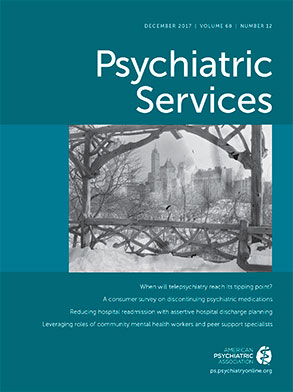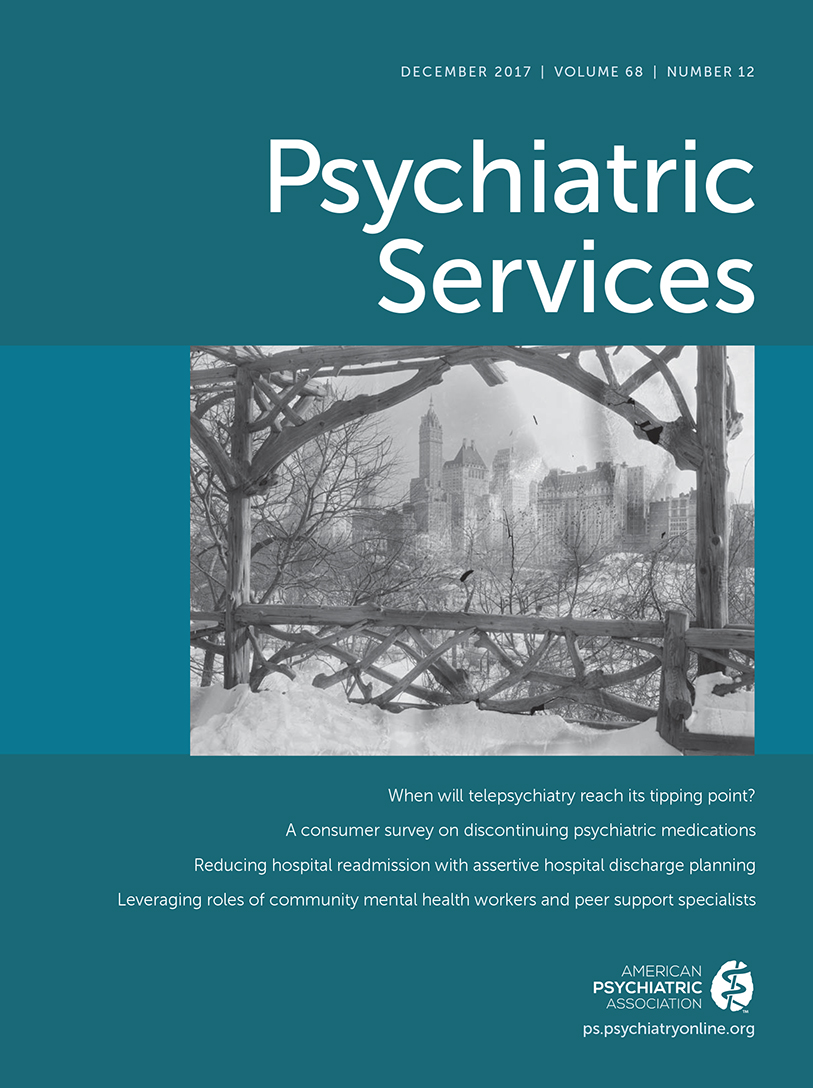Direct-to-consumer advertising (DTCA) by pharmaceutical companies noticeably increased following the Food and Drug Administration’s relaxed guidelines for prescription drug advertisements in 1997 (
1). These guidelines included a mandate that advertisements present all risk factors associated with the drug either within the advertisement or by directing the consumer to where they can find additional information (
2). Little is known about the potential effect of these advertisements on patterns of medication taking among individuals with serious mental disorders in specialty mental health treatment settings. Past research has demonstrated that knowledge gained from DTCA about a medication’s side effects lessened the likelihood of seeking the medication in question (
3), but research has not examined the association between DTCA and the use of medications that a patient is already taking. Hearing a long list of medication side effects could discourage some patients from using prescribed medications and have a negative effect on adherence.
This study examined the relationship between exposure to DTCA and adherence to prescribed medications among individuals with serious mental disorders. We hypothesized that for some patients, exposure to DTCA would be associated with poorer adherence to medications. We further postulated that among patients who were exposed to DTCA and were nonadherent to medications, side-effect information would be a major contributing factor to poor adherence. The study also examined whether patients discussed their concerns about side effects with their physicians, because the physician-patient relationship can have a significant protective effect against nonadherence (
4). We did not distinguish between psychiatric and somatic medications.
Methods
Study participants were drawn from a pool of adult (≥18 years) outpatients at an inner Baltimore City mental health clinic in an academic hospital. Patients with scheduled appointments between June 13, 2016, and July 11, 2016, were invited to participate in a brief anonymous survey by the front desk staff. Patients who had additional appointments during the study period were not offered another chance to participate. No compensation was offered to participate in the study. Information about eligible appointments was collected from the electronic medical records to measure participation rate. Non–English speaking patients and those attending the screening clinic were excluded.
The survey was a 13-item questionnaire developed by the research team to assess exposure to advertising and adherence-related behaviors. The questionnaire also included sociodemographic and clinical factors, including age, gender, education level, and self-reported diagnosis. Before the study, the questionnaire was presented to a group of mental health clinicians not involved in the project for feedback, which was incorporated into subsequent versions in an iterative development process.
All data were nonidentifiable and stored on an encrypted, password-protected computer as part of usual safeguards for human subject data.
Nonadherence was assessed with the following question: “Have you ever missed taking a prescription medication for 2 or more days in one week?” The cutoff of two or more days in any seven-day period was selected to approximate a commonly used measure of nonadherence (≤80% of the time) (
5,
6).
Binary logistic regression models were used to obtain unadjusted and adjusted odds ratios in order to test the association of any exposure to DTCA with nonadherence. The adjusted model controlled for age, sex, education level, and diagnosis. We then assessed whether respondents exposed to DTCA felt that exposure to side-effect information was directly related to self-reported changes in medication-taking behaviors. Finally, among those exposed to DTCA, we examined the role of physician input on patient decisions regarding adherence.
Analyses were conducted using SPSS, version 23. The study was approved by the hospital’s institutional review board. Informed consent for participation was included in the body of the survey.
Results
A total of 246 patients were enrolled (39% of the 630 unique patients seen during the study period). Almost half of the respondents (48%, N=118) reported exposure to DTCA, and 42% (N=104) reported nonadherence, defined as missing medications on two or more days out of any seven days. Sixty-one percent of those exposed to DTCA reported nonadherence (N=72 of 118), compared with 26% of those not exposed (N=32 of 122). A strong association between DTCA exposure and nonadherence was noted in logistic regression analyses (
Table 1). The odds of nonadherence were five times higher for respondents with DTCA exposure than for those without (odds ratio [OR]=5.04, 95% confidence interval [CI]=2.90–8.75, p<.001). This association persisted after adjustment for sex, age, education level, and diagnosis (adjusted OR [AOR]=4.96, CI=2.64–9.33, p<.001).
In the group exposed to DTCA who also reported nonadherence as defined above, 59% (N=42 of 71) reported that they either changed how they took their medication or stopped taking their medication specifically as a result of exposure to side-effect information.
Among respondents exposed to DTCA, 64% (N=94 out of 147 who responded to the question) reported that they discussed concerns about side effects with their physicians. However, among those who did so, only 39% (N=52 out of 135 who responded to this question) waited to speak to their physician before making the changes to their prescribed medications.
Discussion
To our knowledge, this study is the first to examine potential adverse effects of DTCA exposure on adherence to prescribed medications among individuals with serious mental disorders. Past research on DTCA mostly focused on whether exposure to DTCA increases the likelihood that patients request and physicians prescribe medications featured in DTCA (
7). Although these effects of DTCA can potentially lead to unnecessary treatment with health and economic consequences, nonadherence to prescribed treatment also has important health and social repercussions and deserves further scrutiny and study (
5,
8–
10).
Nonadherence is particularly common among individuals with serious mental illness (
5,
6,
10) and can lead to increased health care costs by contributing to wasteful spending from increased use of emergency services and higher rates of hospitalizations, as well as leading to clinical decompensation, homelessness, and substance use disorders (
5,
8,
10,
11). In this survey, the overall rate of self-reported nonadherence was 43%. Among those exposed to DTCA, this rate rose to 61%. Similar to previous studies (
1), we found that the rates of exposure to DTCA were high in this population.
Supporting our hypothesis, we found a significant association between self-reports of DTCA exposure and self-reported medication nonadherence. Notably, the odds of being nonadherent were nearly five times greater among individuals exposed to DTCA than among those not exposed.
Our results also suggested that the side-effect information contained in DTCA may be a factor in the association between exposure to DTCA and self-reported nonadherence. We found that 59% of those exposed to DTCA who also reported nonadherence stated that they either changed the way they took their medication or stopped their medication specifically as a result of exposure to side-effect information.
Previous studies have shown that a typical patient exposed to DTCA is likely to spend far more time listening to, watching, or reading DTCA than in face-to-face interaction with his or her physician (
1). This raises concerns about the limitations of the role of physician input in patients’ decision-making process about their treatment. In this study, the majority (61%) of the respondents who sought physician advice about concerns raised by DTCA and side effect information did not wait to discuss their concerns with their clinicians before they either stopped, or made changes to, the way they took their prescribed medications. Additionally, a substantial proportion (36%) did not take physician input into account at all.
Interpretation of our study results should be done with consideration to its limitations. Because of constraints in resources, data were collected over a limited period and at a single site. The survey was brief and used easy-to-understand language, because the survey was meant to be completed quickly while the patients waited to be seen for their appointments. The required brevity prevented us from assessing different effects of DTCA, such as its potential positive effects on adherence or requesting specific medications. Additionally, questions were not asked regarding the exact timing of exposure and the timing of nonadherence in relation to such exposure. We aimed to capture a broad view of the impact of DTCA at any time on adherence with all medications that the patients were taking. The frequency and the extent of nonadherence were not assessed, nor was the association of nonadherence with specific medication groups examined.
The concurrent or criterion validity of the survey has not been assessed. However, clinicians who reviewed the questionnaire during its development found it to have face validity. Participation rate in the survey was lower than desired. In part, this may have been due to lack of compensation offered for study participation. Only patients who kept their appointments during the study period had a chance to participate, which excluded patients who were poorly adherent to their appointments and possibly more prone to medication nonadherence. Diagnoses in this study were based on patient self-reports and differed from rates obtained via chart reviews of the population of patients at this site (
11), with some patients in the study selecting multiple diagnoses and with the diagnosis of schizophrenia overrepresented. Also, because assessments were based on self-report, the results may be subject to recall and social desirability biases.
Finally, the cross-sectional nature of the data and questions limits causal inference. For example, it is plausible that preexisting negative attitudes and beliefs regarding medications may have influenced both attention to DTCA side effect information and nonadherence. We consider the results of this study preliminary, and they should not be interpreted as a comprehensive assessment of harms and benefits of DTCA.
Conclusions
The findings of this pilot study raise concerns that there may be underappreciated harmful effects of exposure to DTCA on adherence to prescribed medications in a vulnerable patient population, and they suggest that further investigation into these potential effects of DTCA is needed. Investment in DTCA by pharmaceutical companies has markedly increased in recent years, a trend that is likely to continue (
12,
13). Although sharing information about the potential side effects of prescribed medications is an essential element of patient participation in the treatment process, we believe that this information is best provided by the treatment team, who can help the patients understand the magnitude of the risks and the risk-benefit ratio of prescribed treatments. Our findings further highlight the importance of prescriber awareness of the many sources of information, such as listed side effects in DTCA, that affect patient decisions about their care. Furthermore, our results suggest that patients often do not discuss concerns raised by DTCA with their clinicians before acting on the information contained in the advertisement, and we suggest that patients be routinely and proactively questioned about how they learn health and treatment information, with the goal of exploring reluctance to accept or continue taking prescribed medications.

